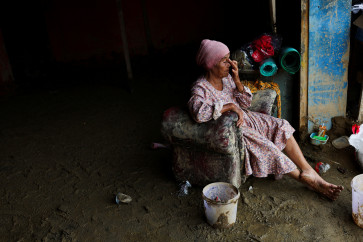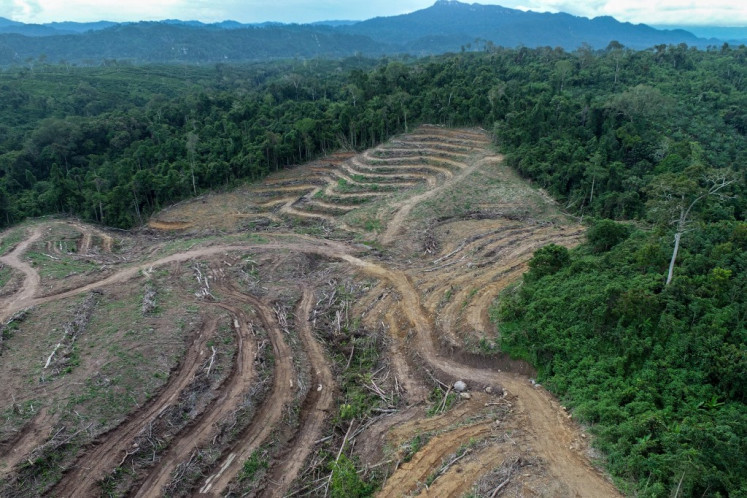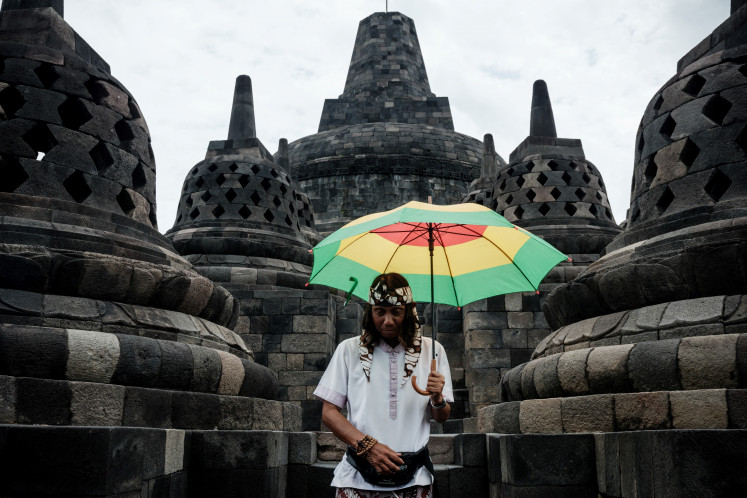Popular Reads
Top Results
Can't find what you're looking for?
View all search resultsPopular Reads
Top Results
Can't find what you're looking for?
View all search resultsSukarno and Pancasila on Limboto's banks
Bamboo memento: Visitors pose with a bamboo replica of the amphibious aircraft, a Consolidated PBY-5A Catalina, used by Sukarno when he visited Gorontalo in 1951
Change text size
Gift Premium Articles
to Anyone
B
span class="caption">Bamboo memento: Visitors pose with a bamboo replica of the amphibious aircraft, a Consolidated PBY-5A Catalina, used by Sukarno when he visited Gorontalo in 1951.
The red-and-white national flag was fluttering in dry wind from a nearby lake. By afternoon on a day in early June, the vast yard of the old building complex on the lakeside was livelier than ever.
Several groups of youths were taking pictures in various spots. Hundreds of monochrome photographs of the past were displayed in a small house, mostly dominated by those of Sukarno, Indonesia's first president.
It was the atmosphere at a museum of the landing of president Sukarno's amphibious airplane in Iluta village on the shores of Lake Limboto, Gorontalo, during the first week of June.
A group of young members of a study club called Kelapa Batu initiated the week-long program to commemorate the founding of Pancasila, the nation's five-principle ideology formulated by one of the country's founding fathers, Sukarno.
The event, from June 1-7, was themed 'The June Celebration, in Honor of the Rightful' and featured Sukarno's historic photos and documents, nationalist films, discussions about Indonesian affairs, poetry reading and traditional music performances.
A painting exhibition by Gorontalo's fine-art community entitled 'Perk up your Indonesian spirit' also enlivened the commemoration. This time, however, they painted on parts of oil drums in response to whatever they felt about the nation on the occasion.
'This is the fifth exhibition we've organized so far,' said Awaluddin Ahmad, one of the program's organizers. They arranged the show for a whole week through the night to give wide opportunities to the public, as Pancasila was declared on June 1, 1945, and Sukarno was born on June 6, 1901.
Welcome: People walk pass the gate leading to the museum that celebrates Sukarno's landing with an amphibious aircraft on the shores of Limboto Lake in Gorontalo.
Pancasila has been seen as a means of unifying the diverse ethnic groups in Indonesia. Yet, according to Awaluddin, in terms of its value this concept is not final. It has to be further explored and expounded. It's a process of negotiation of a pluralist nation.
His group wishes to remind all circles, especially the younger generations, of how a nation of diverse ethnicities called Indonesia has been united by the Pancasila ideology under the motto Bhineka Tinggal Ika (Unity in Diversity).
'We've witnessed various acts of religious or ethnic intolerance as well as corruption lately, which obviously indicate the loss of the spirit and accord to appreciate diversity and humanity as cherished by Pancasila,' he pointed out.
Interestingly, the public event was held with no financial support from the regional administration. The organizing committee relied on proceeds from merchandise and souvenir sales. Some study club members had also been required to save a thousand rupiah daily over several months.
'But some people have voluntarily contributed money and food to our committee while other communities have also joined us to spice up this program,' added Awaluddin.
Although part of the historic zone under the supervision of the region's Cultural Heritage Center, the museum of Sukarno's landing, which was opened by then president Megawati Soekarnoputri on June 29, 2002, only has a limited collection.
On ordinary days, visitors can only watch a number of lackluster reproductions, with information about Sukarno's arrival in Gorontalo, which was reportedly aimed at preventing a civilian rebellion against the Republic of Indonesia. Various other exhibits like books by Sukarno, old radio sets and historic objects have been contributed by citizens.
The wooden quay especially built to welcome the arrival of Sukarno only has a few of its piles still intact and all of its wooden parts have been replaced by concrete.
To increase the collection, Kelapa Batu members hunted for photos in various places. Some pictures were borrowed from the Gorontalo Regional Library and Archives, the National Archives of the Republic of Indonesia and a collector of historic items.
Historical house: Paintings that depict Sukarno and Mohammad Hatta as the latter reads out the Independence Proclamation are placed at the museum during a week-long event held in early June by the Kelapa Batu study club.
As a result, no less than 100 historic photos, post cards, totems, magazines, important documents and recordings of Sukarno's speeches became highlights of the exhibition.
One of the pictures depicted Sukarno, wearing his cap and typical jacket, waving to a crowd of Gorontalo people as he reached the Iluta quay, Lake Limboto ' the present museum's location ' on Nov. 20, 1951.
Lake Limboto indeed testified to the first arrival of the great revolutionary commander and the son of dawn, as Sukarno was widely addressed at the time.
At the lake, which in 1932 was 30 meters deep with a total area of 7,000 hectares, Sukarno landed in a legendary US-made amphibious warplane, the Consolidated PBY-5A Catalina. PB stands for patrol bomber while Y designates Consolidated as the manufacturer.
In order to arouse visitors' imagination, Awaluddin and his colleagues made a replica of the plane that triumphed during World War II. But the 'Catalina' was crafted out of bamboo, complete with propellers. 'It's almost 10 meters, half of the actual length,' he said.
Over a thousand bamboo pieces were consumed in building the replica, which took nearly three months. Unsurprisingly, the outstanding exhibit became one of visitors' favorite spots for photographs.
'We're grateful to the youth group for initiating this educative program. The children are taking a great interest and they can learn a lot of lessons from it,' said Hayati, a primary school teacher, who came along with her students.
But one thing that made her anxious was the filthy condition of Lake Limboto, filled with garbage and almost entirely covered by water hyacinths.
'It's hard to imagine how the amphibious aircraft carrying Sukarno could have landed on this lake if it had been in its present state,' she said, shaking her head.
Miman Adam, a keeper of the museum, said he was happy to see another celebration of the historic day because of the very small number of visitors for most of the year. 'If any come along, they're just courting couples,' he added, smiling.
The historic house also bears witness to the fate of Lake Limboto, which dries up to form an immense field in the dry season and has the capacity to overflow and inundate settlements in the rainy season.
' Photos by JP/Syamsul Huda M. Suhari













